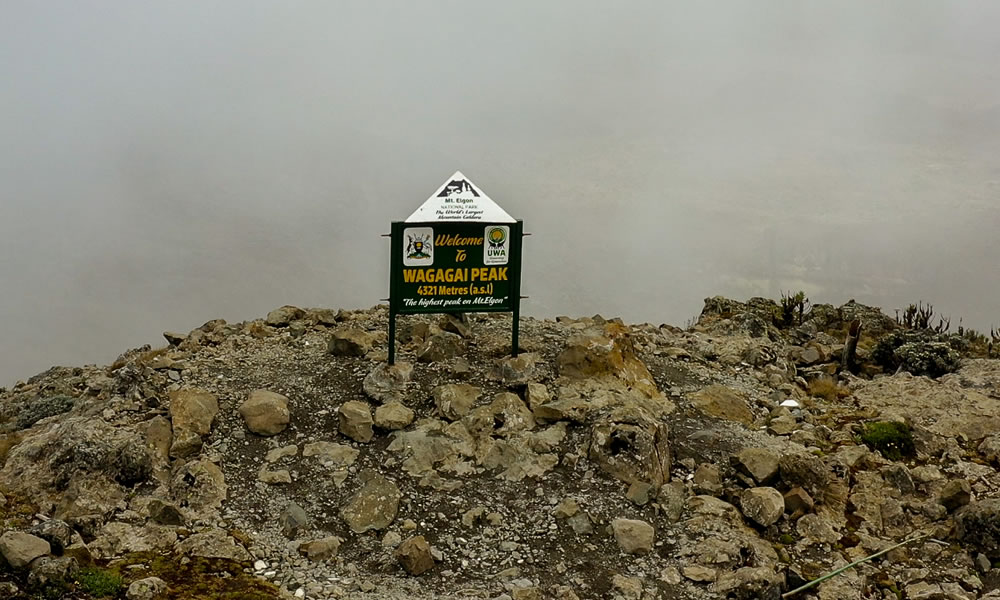A UNESCO Man and Biosphere Reserve, Mount Elgon National Park is situated near the Kenyan border with Uganda. The park has a 494 square mile size. The Ugandan side of the border occupies a bigger portion of the park, covering 430 square miles. In 1992, the Ugandan portion was made into a national park after being promoted from a forest reserve. The park’s most notable geographical feature, Mount Elgon, is the source of its name. Volcano Mount Elgon erupted more than 24 million years ago. It is now extinct. It is the eighth-highest mountain in Africa and the tallest volcanic mountain in East Africa.

The world’s largest caldera, measuring roughly 60 kilometres in length and 40 kilometres in width, is found atop Mount Elgon. The collapse of the cone is the result of magma being drained from the bottom, creating this specific Caldera. Before millions of years of erosion significantly lowered its height, scientists believe that Mount Elgon was once Africa’s highest mountain.
The group of flora that changes with altitude is supported by the fertile slopes of Mount Elgon. They consist of alpine moorlands near the top, bamboo forests on higher lands, and montane forests in the lower regions. There are 143 known species of birds and more than 400 plant species. Mount Elgon National Park is home to half of Uganda’s butterfly species, including the critically endangered Maathai’s Lonleg dragonfly, which was only identified there in 2000. Numerous mammals can be found on the lower slopes of the highlands, including blue and black-tailed monkeys, buffalo, elephants, red-tailed monkeys, spotted hyenas, oribi, Defassa waterbucks, bushbucks, and lesser antelopes.
The Sabiny and Bagisu tribes are the principal inhabitants of the park’s Ugandan portion. For their subsistence, these tribes farm. Due to its success in the rich soils found on the lower slopes of the mountains, Arabica coffee is the speciality of the Bagisu people. In close collaboration with its Kenyan colleagues, the Uganda Wildlife Authority protects and manages the higher slopes of the mountains. In Mbale town, the Mountain Elgon National Park office is situated along Masaba Road. Visitors can go here to get information or obtain permits for activities related to the park. Permits for activities in Mountain Elgon National Park are also issued by the Uganda Wildlife Authority headquarters located in Kampala.
Things to do in Mount Elgon National Park
Climbing Mount Elgon
There are benefits to climbing Mount Elgon as opposed to Tanzania’s Mount Kilimanjaro or the Rwenzori Mountains. It is less costly, less taxing, and even at the summit, the temperatures are comfortable. Climbing Mount Elgon is special not because you reach the top of Wagagai but rather because you descend to see the world’s largest caldera. Depending on the path taken, climbing Mount Elgon can take four to six days. The Salsa Trail, Pisa Trail, and Sipi Trail are the three primary beginning points. Although the Salsa Trail is shorter, it has quite steep climbs. It is also known as the Buddukiro trailhead.
It takes just four days to go to the top from the vicinity of Mbale town. Despite being the shortest path, it passes through the park’s densest stretch of bamboo trees. The Pisa trail, sometimes referred to as the Kapkwata trailhead, is the second trail. This trek begins in a Kapkwata woodland and travels through magnificent Podocarpus trees.
Exploring the Mount Elgon Caves
You can request to go on shorter day hikes or explore some of the numerous caverns that are situated on the mountain’s slopes if you’re not ready to ascend the entire mountain. The Kitum, Mackingeny, and Chepnyali caves are the most frequented. The park animals that come to these caverns to lick the salt off the walls include antelopes and elephants. Cave display at Mount Elgon National ParkThere are additional ancient caves with murals that date back thousands of years that are similar to the caverns at Budadiri. Visitors love Wanale’s Khauka and Kapkwai caverns because of its layout and the large number of bats that form manure out of their droppings.
These caverns provided shelter for the residents. The Nyero Rock Painting Caves are worth visiting; they are situated west of the town of Mbale. These caverns served as havens for the early wandering humanity. They have left their imprint with their amazing artwork that depict their way of life from thousands of years ago.
Bird Watching
Bird Watching at the national park of Mount Elgon entails seeing species that are unique to the area. Numerous locations offer good bird watching opportunities, such as the park’s dense underbrush, the Cheptui Falls, and the Forest Exploration Centre at Kapwai. African Goshawks, African Blue Fly-catchers, Black-shouldered Kites, Chubb’s Cisticola, Crowned Hornbills, Black-collared Apalis, Black-shouldered Kites, Doherty’s and Luhder’s Bush-Shrikes, Golden Winged and Tacazze sunbirds, Hartlaub’s turaco, Mackinon’s Fiscal, Ross’s and Hartlaubs Turacos, and White-chinned Prinia can all be found in the park. Only Uganda’s Mount Elgon National Park is home to the critically endangered Jackson’s Francolin and Lammergeyer.
Forest and Nature Walks
The lush forest and other greenery that Mount Elgon National Park is home to are made possible by the park’s abundant rainfall and good soils, which also make nature walks incredibly rewarding. Numerous birds, animals, and dense montane vegetation are encountered by tourists as they ascend the mountain or explore the tunnels. As one enters the moorlands on the mountain’s upper slopes, they are exposed to breathtaking scenery and uncharted territory.
Camping
Camping is allowed at Mountain Elgon National Park and the surrounding area. For individuals who wish to hike to the summit of the mountain, the park officials have established camping bases along the mountain climbing pathways. It is forbidden to camp close to the caldera. Travellers should include lightweight camp stoves, sleeping bags, tents, rain coats, and warm clothing. The park office in Mbale town is where you may rent sleeping bags and tents.
Visiting Waterfalls
Beautiful waterfalls are created by the rivers that flow from the top of the mountain as they pass through cliffs. The most picturesque waterfalls in the region are the Sipi falls. Just past the Forest Exploration Centre, just beyond the park’s boundaries, are these stunning falls. Hiking through the village houses and farmlands in the area is necessary to get to the falls. There are high-quality hotels and lodges in the vicinity of the falls. In addition to the Sipi Falls, there are waterfalls in Bulago, Chebonet, Sisyi, and Wanale.
Abseiling
Abseiling entails descending a cliff while wearing a harness that is fastened with a sturdy rope-like device. The only place in Uganda where abseiling is organised is the Sipi Falls. The activity is expertly planned, with high-quality imported equipment, qualified instructors, and guides that make sure everyone is safe.
Rock Climbing
Rock climbing is one of the most popular recreational pursuits offered outside of Mount Elgon National Park. There’s excellent rock climbing around Sipi Falls. The worst ascent in the Sipi region is about 35 metres. The next town, Tororo, has an impressive rock next to the town square. It’s easy for hikers to drive there. Give yourself three hours to climb Tororo Rock. Those that reach the summit will be rewarded with breathtaking views of Mount Elgon, the surrounding towns, and the town below.
